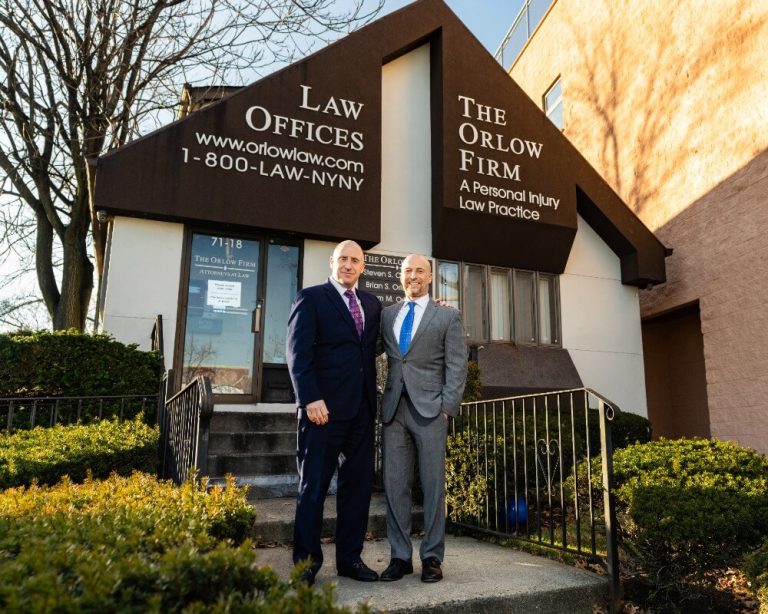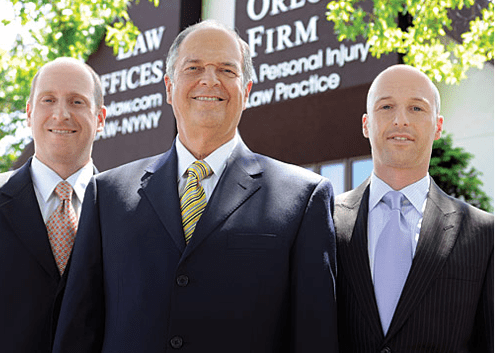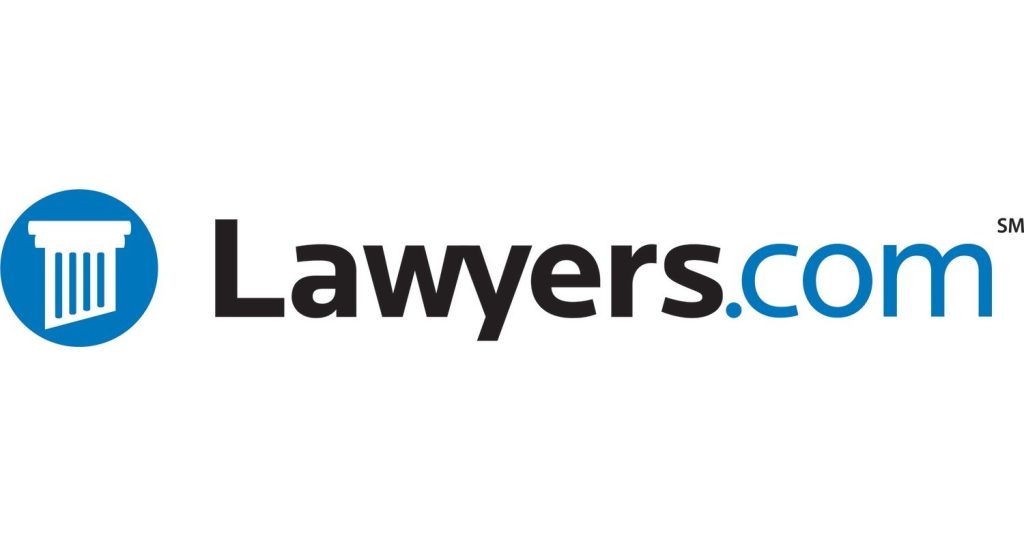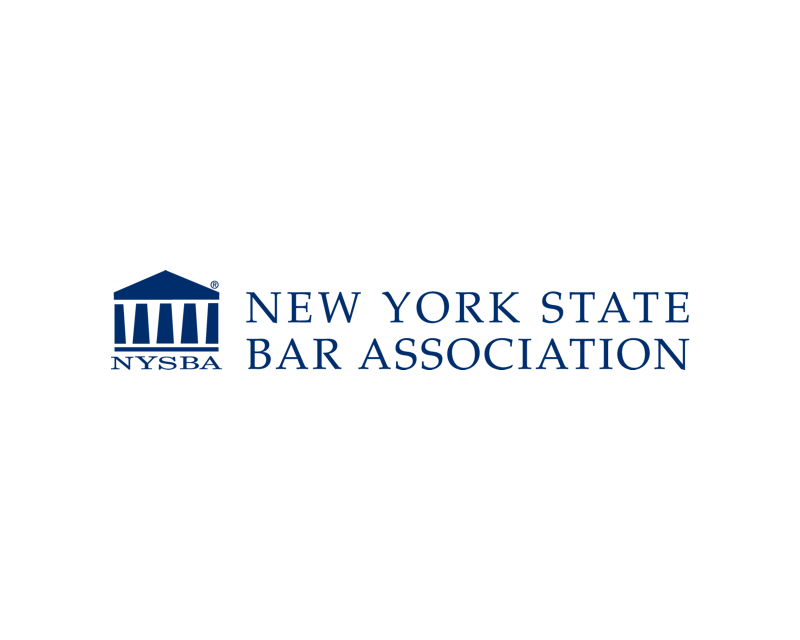The Following People Contributed to This Page
Cindy Cordova is a seasoned legal writer with over seven years of experience crafting clear, informative, and professional content for law firm websites. With a B.A. in English from Trinity Christian College, she combines her strong writing background with a deep understanding of legal topics to help firms connect with their clients through trustworthy and accessible content.
- June 6, 2025
Who Can Be Held Liable in a Construction Accident?
Quick Answer: In a New York City construction accident, potential parties that can be held liable include the property owner, general contractor, subcontractors, equipment manufacturers, and sometimes architects or engineers, depending on their level of control and responsibility over the site and safety conditions. For personalized guidance, contact The Orlow Firm at (646) 647-3398 to discuss your case with our construction injury lawyers.
Common Parties Held Liable in Construction Accidents
Construction accidents can be complex, involving multiple parties who may be held liable for injuries sustained. In New York City, understanding who might be responsible is crucial for anyone involved in such an incident. Below, we explore some of the common parties that can be held liable in construction accidents.
- Employers: Employers have a duty to maintain a safe working environment. If they fail to provide adequate training, safety equipment, or follow safety regulations, they may be held liable for any resulting injuries.
- General Contractors: General contractors oversee the construction site and are responsible for ensuring that safety standards are met. If they neglect to implement safety measures or monitor subcontractors adequately, they could be liable for accidents.
- Subcontractors: Subcontractors are often hired to perform specific tasks on a construction site. They are responsible for ensuring their work does not pose a hazard to others. If their negligence leads to an accident, they may be held accountable.
- Property Owners: Property owners may be held liable if they knew or should have known about unsafe conditions on the site and failed to address them. Their level of responsibility can vary depending on their involvement in the construction project.
- Manufacturers of Equipment: If faulty equipment contributes to a construction accident, the manufacturer of that equipment could be held liable. This includes cases where equipment is defective or lacks proper safety features.
- Architects and Engineers: These professionals are responsible for designing safe structures and ensuring that construction plans comply with safety regulations. They can be held liable if design flaws or oversight contribute to an accident.
It’s important to note that liability in construction accidents can involve multiple parties, and determining who is responsible requires a thorough investigation. Each case is unique, and the specific circumstances will dictate who can be held liable. If you or a loved one has been injured in a construction accident in New York City, understanding your rights and the potential parties responsible is vital. For guidance tailored to your situation, contact The Orlow Firm at (646) 647-3398 to discuss your case with our compassionate and experienced attorneys.
Employer Responsibilities and Liability
In the event of a construction accident in New York City, understanding employer responsibilities and liability is crucial for determining who may be held accountable. Employers have specific obligations under both federal and state laws to ensure the safety of their workers. If they fail to meet these obligations, they may be held liable for any resulting injuries.
Ensuring a Safe Work Environment
Employers are required by law to provide a safe work environment. This includes conducting regular safety inspections, providing appropriate safety gear, and ensuring that all equipment is in good working condition. Employers should also implement safety protocols and provide comprehensive training to workers on how to avoid accidents and respond to emergencies.
Compliance with OSHA Regulations
The Occupational Safety and Health Administration (OSHA) sets forth standards that employers in the construction industry must follow. These regulations cover various aspects of workplace safety, including the use of scaffolding, ladders, and hazardous materials. Employers who fail to comply with OSHA standards may face penalties and increased liability if a worker is injured due to such negligence.
Workers’ Compensation Coverage
In New York, most employers are required to carry workers’ compensation insurance. This insurance provides benefits to employees who are injured on the job, covering medical expenses and a portion of lost wages. However, workers’ compensation is ordinarily the exclusive remedy for injured employees; a direct lawsuit against the employer is permitted only when the employer commits an intentional tort.
Third-Party Liability
While workers’ compensation limits the ability to sue the employer directly, injured workers may still pursue claims against third parties who contributed to the accident. For example, if a subcontractor or equipment manufacturer was negligent, they could be held liable in addition to the employer. Understanding the interplay between employer liability and third-party claims is essential for maximizing compensation.
Employer Liability in Multi-Employer Worksites
Construction projects often involve multiple employers working on the same site. In such cases, determining liability can be complex. Each employer is responsible for their own workers’ safety, but they may also be held liable if their actions or inactions create hazards that affect employees of other companies on the site.
If you or a loved one has been injured in a construction accident, it’s important to understand your legal rights and the potential liabilities involved. For personalized guidance, contact The Orlow Firm at (646) 647-3398 to discuss your specific situation with our dedicated team.
Contractors and Subcontractors: Who is Liable?
In the complex landscape of construction accidents, determining liability can be particularly challenging, especially when it involves contractors and subcontractors. In New York City, where construction is a booming industry, understanding the nuances of liability is crucial for anyone affected by a construction accident.
Contractors and subcontractors play pivotal roles in construction projects, and their responsibilities and potential liabilities are often intertwined. Here’s a breakdown of how liability may be determined for these parties:
- General Contractors: In many construction projects, the general contractor is responsible for overseeing the entire project. This includes ensuring that safety protocols are followed and that the work site complies with federal, state, and local safety regulations. If a construction accident occurs due to negligence in maintaining safety standards, the general contractor may be held liable.
- Subcontractors: Subcontractors are hired to perform specific tasks within a construction project, such as electrical work, plumbing, or masonry. Each subcontractor is responsible for the safety of their own work area and employees. If an accident occurs due to a subcontractor’s failure to adhere to safety protocols or due to faulty workmanship, they may be held liable.
- Shared Liability: In some cases, both contractors and subcontractors might share liability for an accident. For example, if a subcontractor fails to follow safety guidelines but the general contractor was aware of these violations and did nothing to address them, both parties could be held responsible.
- Contractual Obligations: Liability can also be influenced by the terms set out in the contracts between the parties involved. Contracts often specify who is responsible for specific safety measures and who assumes liability in the event of an accident. Reviewing these contracts is essential in determining liability.
New York’s labor laws, such as the New York Labor Law Sections 240 and 241, often come into play in construction accident cases. These laws offer protections to workers and can impose strict liability on contractors and owners for certain types of accidents, such as falls from heights. It is important to consult with a knowledgeable attorney who can navigate these complex legal frameworks.
Determining liability in construction accidents requires a detailed examination of the specific circumstances of the accident, the roles and responsibilities of the contractors and subcontractors, and the applicable laws. If you or a loved one has been involved in a construction accident in New York City, it is crucial to seek legal assistance to explore your options. For professional guidance, contact The Orlow Firm at (646) 647-3398 to discuss your case with our dedicated team.
Property Owners Liability in Construction Accidents
In New York City, property owners have specific responsibilities when it comes to maintaining a safe environment on construction sites. Failure to meet these responsibilities can lead to liability in the event of a construction accident. Understanding the nuances of property owners’ liability is crucial for anyone involved in a construction-related incident.
General Duty of Care
Property owners in NYC owe a general duty of care to ensure that their premises are reasonably safe for workers and visitors. This includes addressing potential hazards and ensuring compliance with safety regulations. If a property owner neglects this duty and an accident occurs as a result, they may be held liable for any resulting injuries.
Role in Construction Projects
Property owners who are actively involved in the construction project, such as by overseeing work or hiring contractors, may have increased liability. Their level of involvement can determine the extent of their responsibility. For instance, if a property owner hires a contractor known for poor safety practices, they might be liable for accidents stemming from those practices.
New York Labor Laws
New York State has enacted specific labor laws that can impact a property owner’s liability in construction accidents. Notably, Labor Law 200, Labor Law 240 (often referred to as the “Scaffold Law”), and Labor Law 241 impose strict safety obligations on property owners and contractors:
- Labor Law 200 : This law codifies the common-law duty to provide a safe work environment. Property owners can be held liable if they exercise control over the work and are aware of safety hazards.
- Labor Law 240 : Known as the “Scaffold Law,” this statute places absolute liability on property owners and contractors for elevation-related injuries, such as falls from heights, if safety devices are not provided.
- Labor Law 241 : Labor Law § 241(6) imposes a non-delegable duty on owners and contractors to comply with the Industrial Code; liability attaches only when a specific Industrial Code provision is violated and that violation proximately causes the injury.
Insurance and Indemnity Agreements
Property owners often carry liability insurance and may include indemnity clauses in contracts with contractors to protect themselves financially. However, these measures do not absolve them of liability but rather provide a means to share or transfer financial responsibility.
Example Scenarios in NYC
Consider a scenario where a worker falls from an improperly secured scaffold at a Manhattan construction site. If the property owner knew about the unsafe conditions and failed to address them, they could be held liable under Labor Law 240. Similarly, if a property owner failed to ensure that appropriate safety measures were in place during excavation work, resulting in a cave-in, they might be liable under Labor Law 241.
Understanding the potential for property owner liability in construction accidents is vital for anyone injured on a construction site. If you or a loved one has been involved in a construction accident in New York City, it is important to assess all potential avenues for compensation. For personalized legal guidance, contact The Orlow Firm at (646) 647-3398 to discuss your specific situation with our dedicated personal injury attorneys.
Manufacturers and Equipment Liability in Construction Accidents
In the bustling environment of New York City, construction sites are a common sight. However, these sites can also be dangerous, leading to accidents that cause severe injuries. When such accidents occur, liability doesn’t always rest solely on the shoulders of the construction companies or workers. In many cases, manufacturers and equipment suppliers can also be held liable for construction accidents. Understanding how and when these parties might be responsible is crucial for injured workers seeking compensation.
When Manufacturers May Be Liable
Manufacturers can be held liable in construction accidents if the equipment or machinery they produce is found to be defective. A defect can be in the design, manufacturing process, or even a failure to provide adequate warnings or instructions. Here are situations where a manufacturer might be held responsible:
- Design Defects: If the product was manufactured according to specifications but the design itself is inherently unsafe, the manufacturer might be liable. For example, if a crane’s design makes it unstable under normal operating conditions, this could be a design defect.
- Manufacturing Defects: These occur when the product deviates from its intended design due to errors in the manufacturing process. A batch of safety harnesses with faulty stitching could be an example of a manufacturing defect.
- Failure to Warn: If the manufacturer fails to provide adequate warnings or instructions about the potential risks of using their product, they might be liable. For instance, if a piece of machinery requires specific safety precautions that are not clearly communicated, this could be grounds for liability.
Equipment Suppliers and Their Role
Equipment suppliers in New York City might also share liability if they knowingly provided defective equipment or failed to maintain it properly. Here’s how they might be implicated:
- Negligent Maintenance: If a supplier is responsible for maintaining equipment and fails to perform necessary upkeep, leading to an accident, they can be held liable. For example, a rental company that provides scaffolding must ensure it is in safe working condition.
- Inadequate Inspection: Suppliers are expected to inspect equipment before it is delivered to a construction site. If an accident occurs because the supplier did not adequately inspect the equipment for defects or damage, they could be held responsible.
Proving Manufacturer or Supplier Liability
Establishing liability for manufacturers and suppliers in construction accidents often requires a thorough investigation. It involves:
- Gathering Evidence: Collecting evidence such as maintenance records, design blueprints, and witness statements can help establish how the equipment was defective.
- Expert Testimony: Legal cases often require expert analyses to demonstrate how a defect contributed to the accident. Experts can provide insights into whether the equipment met industry standards and safety regulations.
- Product Recalls: If there have been recalls or previous reports of defects for the equipment, this information can be pivotal in proving liability.
Understanding who can be held liable in construction accidents can be complex, especially when multiple parties are involved. If you or a loved one has been injured in a construction accident in New York City, it’s important to consult with a knowledgeable attorney who can navigate the intricacies of such cases. For personalized guidance, contact The Orlow Firm at (646) 647-3398 to discuss your situation and explore your legal options.
How New York Labor Laws Impact Liability
New York Labor Laws play a crucial role in determining liability in construction accidents. These laws are designed to protect workers’ rights and ensure safe working conditions on construction sites. Understanding these laws is essential for identifying who may be held liable in the event of an accident.
New York Labor Law Sections 200, 240, and 241
Three key sections of New York Labor Law often come into play in construction accident cases:
- Section 200 : This section is a general duty clause that mandates all employers and property owners to provide a safe work environment. It covers basic safety practices and requires that all machinery, equipment, and workplaces are constructed, equipped, and operated to provide reasonable and adequate protection to workers.
- Section 240 : Commonly known as the “Scaffold Law,” this section is specific to elevation-related risks. It imposes strict liability on contractors and property owners for any injuries resulting from falls or falling objects due to inadequate or missing safety equipment, such as scaffolding, hoists, and ladders. Labor Law § 240 is intended to protect workers from elevation-related hazards and imposes absolute liability on owners and contractors unless the worker’s own conduct is the sole proximate cause of the accident.
- Section 241 : This section outlines specific safety regulations for construction, excavation, and demolition work. It mandates compliance with detailed safety standards and holds contractors and property owners liable for any violations that lead to injury. The law covers a wide range of activities and is aimed at ensuring comprehensive safety measures are in place.
Impact on Liability
The impact of these laws on liability is significant. Under Section 240, for instance, liability is often absolute, meaning that if a violation of the Scaffold Law leads to an injury, the property owner or contractor may be held liable regardless of whether they were directly at fault. This can simplify the process for injured workers seeking compensation, as they do not need to prove negligence.
Sections 200 and 241 require a demonstration that the property owner or contractor failed to uphold safety obligations, which can involve showing that they had control over the work site or were aware of the unsafe conditions. These sections provide a framework for holding parties accountable when safety standards are not met.
Examples in New York City
In a bustling metropolis like New York City, construction sites are ubiquitous, and accidents can have severe consequences. For example, if a worker falls from a scaffold in Manhattan due to a lack of proper safety harnesses, Section 240 could be invoked to hold the property owner and contractor liable for the injuries sustained. Similarly, if a site in Brooklyn fails to implement adequate lighting during nighttime operations, leading to an accident, Section 241 might be applied to establish liability.
Understanding these laws and their implications is crucial for anyone involved in a construction accident. If you or a loved one has been injured on a construction site in New York City, it’s important to seek legal guidance to navigate these complex laws and ensure your rights are protected. For assistance, contact The Orlow Firm at (646) 647-3398 to discuss your case with our dedicated legal team.
Steps to Determine Liability After a Construction Accident
Determining liability in a construction accident can be a complex process, particularly in a bustling city like New York. Multiple parties may be involved, and various factors must be considered to pinpoint who is legally responsible. Here’s a step-by-step guide to help understand how liability is determined after a construction accident.
- Gather Evidence : The first step in determining liability is collecting all relevant evidence from the accident scene. This includes photographs, video footage, witness statements, and any available accident reports. Documentation of the scene can provide crucial insights into how the accident occurred and may help identify potential liable parties.
- Identify All Involved Parties : Construction sites typically involve multiple parties, including contractors, subcontractors, property owners, equipment manufacturers, and more. Identifying all parties involved in the construction project is essential in understanding who may have contributed to the unsafe conditions leading to the accident.
- Review Contracts and Agreements : Examine the contracts and agreements between the different parties involved in the construction project. These documents often outline responsibilities and safety obligations, which can be critical in determining liability. For instance, a contractor may be responsible for ensuring safety measures, while a subcontractor might be tasked with specific safety protocols.
- Consult Applicable Laws and Regulations : In New York, specific labor laws and safety regulations apply to construction sites. Reviewing these laws, such as New York Labor Law Sections 200, 240 (often called the “Scaffold Law”), and 241, can help determine if there was a violation that led to the accident. These laws impose strict liability on certain parties, depending on the circumstances.
- Analyze Safety Records and Procedures : Investigate the safety records and procedures that were in place at the time of the accident. This includes reviewing any previous safety violations, training records, and compliance with Occupational Safety and Health Administration (OSHA) standards. A history of negligence or inadequate safety measures can be indicative of liability.
- Consult with Experts : In many cases, it may be necessary to consult with construction safety experts or legal professionals who specialize in construction accidents. These experts can provide valuable insights and help interpret technical aspects of the case, which can be crucial in establishing liability.
- Determine Causation : Establishing causation is a critical step in proving liability. This involves demonstrating a direct link between the actions or negligence of a party and the injuries sustained. For example, if faulty equipment caused the accident, the manufacturer might be held liable for failing to ensure the product’s safety.
Determining liability in construction accidents requires a thorough investigation and a comprehensive understanding of the legal landscape. If you or a loved one has been involved in a construction accident in New York City, it’s important to seek legal guidance to navigate these complexities. The Orlow Firm is here to assist you. Contact us at (646) 647-3398 for a personalized consultation to discuss your situation and explore your legal options.
Common Defenses Used in Construction Accident Liability Cases
In the aftermath of a construction accident, determining liability can be a complex process. Those accused of being responsible for an accident often employ various defenses to mitigate or eliminate their liability. Understanding these defenses can be crucial for injured parties seeking compensation. Below, we explore some common defenses used in construction accident liability cases in New York City.
- Comparative Negligence: In New York, the principle of comparative negligence allows for the allocation of fault among all parties involved in an accident, including the injured party. A defendant might argue that the injured worker’s own negligence contributed to the accident, potentially reducing the compensation the worker can receive. For example, if a worker was not following safety protocols or was distracted, this defense might be used to argue that they are partially responsible for their injuries.
- Assumption of Risk: This defense asserts that the injured party knowingly and voluntarily assumed the risks inherent in their job or the specific task that led to the injury. In the construction industry, certain hazards are well-known, and if a worker was aware of these risks and chose to proceed, the defense might argue that the worker assumed those risks. However, this defense has limitations, especially if safety regulations were violated or the risks were not adequately communicated.
- Statutory Compliance: Defendants may argue that they adhered to all relevant safety regulations and codes, suggesting that they took all necessary precautions to prevent accidents. If a company can demonstrate compliance with industry standards and safety laws, they may argue that the accident was unforeseeable and not due to any negligence on their part.
- Unforeseeable Circumstances: Sometimes referred to as “Acts of God,” this defense claims that the accident was caused by unforeseen and uncontrollable events, such as extreme weather conditions. If a construction accident was caused by a sudden, unexpected event that could not have been anticipated or prevented, the defense might argue that liability should not be assigned to any party.
- Third-Party Liability: A common defense is to shift the blame to another party, such as a subcontractor, equipment manufacturer, or another worker. By identifying another responsible party, the defendant can argue that they should not be held liable for the accident. This defense often involves complex investigations into the roles and responsibilities of various parties involved in the construction project.
Understanding these defenses is crucial for anyone involved in a construction accident case. If you or a loved one has been injured in a construction accident in New York City, seeking legal guidance can help you navigate these defenses and pursue the compensation you deserve. Contact The Orlow Firm at (646) 647-3398 to discuss your case with our experienced personal injury attorneys.
Frequently Asked Questions About Construction Accident Liability
In the wake of a construction accident, determining liability is often complex, and many individuals have questions about who can be held accountable. Below, we address some of the most frequently asked questions regarding construction accident liability in New York City.
- Who can be held liable in a construction accident? Liability in construction accidents can extend to multiple parties, including employers, general contractors, subcontractors, property owners, and equipment manufacturers. Each of these parties has specific duties and obligations under New York law, and failure to adhere to safety standards can result in liability.
- What role do New York labor laws play in construction accident liability? New York has specific labor laws, such as the New York Labor Law Sections 200, 240, and 241, which are designed to protect construction workers. These laws impose strict liability on certain parties, meaning they can be held responsible even if they did not directly cause the accident. For instance, Labor Law 240, often referred to as the “Scaffold Law,” holds property owners and contractors liable for gravity-related injuries.
- Can an injured worker sue their employer for a construction accident? Generally, in New York, workers cannot sue their employers if they are covered by workers’ compensation. However, they may have grounds to sue third parties, such as contractors, property owners, or equipment manufacturers, if these parties contributed to the accident.
- What if faulty equipment caused the accident? If defective equipment contributed to the accident, the manufacturer or distributor of that equipment could be held liable. This falls under product liability claims, where the injured party must demonstrate that the equipment was defective and that defect led to the injury.
- How can I prove liability in a construction accident? Proving liability involves gathering evidence such as safety reports, witness statements, and expert testimonies. It’s crucial to document the accident scene and any equipment involved. Hiring an attorney experienced in construction accidents can be invaluable in navigating these complexities.
- What defenses might be used in a construction accident liability case? Common defenses include arguing that the injured party was negligent, did not follow safety protocols, or that the injury was not as severe as claimed. Understanding these defenses can help in preparing a strong case.
If you or a loved one has been involved in a construction accident in New York City and need guidance on potential liability, The Orlow Firm is here to assist. Our attorneys are dedicated to helping you understand your rights and options. For personalized legal support, contact us at (646) 647-3398.
How The Orlow Firm Assists with Construction Accident Claims
When it comes to construction accident claims in New York City, The Orlow Firm is dedicated to providing comprehensive legal assistance tailored to the unique needs of each client. Our approach is centered around understanding the complexities of construction accident liability and seeking the full compensation to which our clients may be entitled.
- Thorough Investigation – Our first step in handling a construction accident claim is to conduct a thorough investigation of the incident. This includes gathering evidence from the accident scene, reviewing safety records, and interviewing witnesses. We meticulously analyze all aspects of the case to identify all potentially liable parties, such as contractors, subcontractors, property owners, and equipment manufacturers.
- Understanding New York Labor Laws – New York has specific labor laws that protect construction workers, including Labor Law Sections 200, 240, and 241. Of these, only Section 240 imposes strict or absolute liability. Section 200 is based on principles of negligence, while Section 241(6) requires proof of a violation of a specific provision of the Industrial Code. Our team is well-versed in these laws and uses them strategically to build strong cases for our clients.
- Identifying Liable Parties – Construction accidents often involve multiple parties, each with different responsibilities. We work diligently to identify all parties who may be liable for the accident. This can include general contractors, subcontractors, property owners, and even equipment manufacturers. Our goal is to ensure that every responsible party is held accountable, pursuing all legally available compensation for our clients.
- Negotiating with Insurance Companies – Insurance companies often attempt to minimize payouts. Our attorneys negotiate diligently on behalf of our clients to pursue fair compensation. We handle all communications and negotiations with insurance companies, allowing our clients to focus on their recovery.
- Litigation Support – If a fair settlement cannot be reached through negotiation, The Orlow Firm is prepared to take the case to court. Our attorneys have extensive experience in litigation and are committed to presenting a compelling case to achieve the best possible outcome for our clients.
- Personalized Client Support – At The Orlow Firm, we understand the emotional and physical toll a construction accident can take. We provide compassionate and personalized support throughout the legal process, ensuring that our clients feel informed and empowered every step of the way.
If you or a loved one has been involved in a construction accident in New York City, don’t hesitate to contact The Orlow Firm at (646) 647-3398. Our dedicated team is ready to assist you in navigating the complexities of your claim and fighting for full and fair compensation under New York law.
The Following People Contributed to This Page
Cindy Cordova is a seasoned legal writer with over seven years of experience crafting clear, informative, and professional content for law firm websites. With a B.A. in English from Trinity Christian College, she combines her strong writing background with a deep understanding of legal topics to help firms connect with their clients through trustworthy and accessible content.











